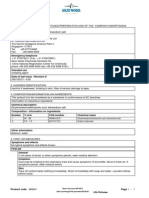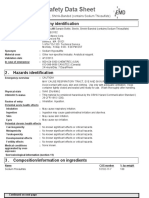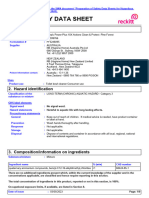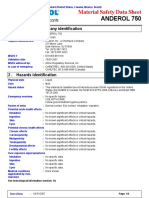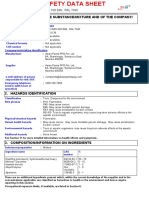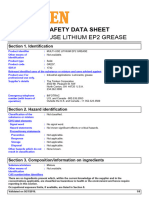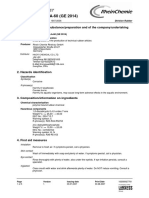DEDM0429 - Siemens AUS MSDS - Australia - Euk
DEDM0429 - Siemens AUS MSDS - Australia - Euk
Uploaded by
heru ramadhanCopyright:
Available Formats
DEDM0429 - Siemens AUS MSDS - Australia - Euk
DEDM0429 - Siemens AUS MSDS - Australia - Euk
Uploaded by
heru ramadhanOriginal Description:
Original Title
Copyright
Available Formats
Share this document
Did you find this document useful?
Is this content inappropriate?
Copyright:
Available Formats
DEDM0429 - Siemens AUS MSDS - Australia - Euk
DEDM0429 - Siemens AUS MSDS - Australia - Euk
Uploaded by
heru ramadhanCopyright:
Available Formats
Material Safety Data Sheet
Dimension CHEM 1 Calibrator MSDS no.: DEDM0429
1. Identification of the material and supplier
Names
Product name : Dimension CHEM 1 Calibrator
Product code : DC18C, 10716280
Supplier
Supplier/Manufacturer : Siemens Healthcare Pty Ltd.
885 Mountain Highway
Bayswater VIC 3153
Technical Information:
1800 310 300
e-mail : dx.msds.healthcare@siemens.com
Emergency telephone : 13 11 26 (Poison Information Centre) - 24 hours
number 02 9037 2994 (CHEMTREC) - 24 hours
+1 703-527-3887 (CHEMTREC international number) - 24 hours
Uses
Area of application : Industrial applications.
Material uses : Diagnostic agents.
Product type : Solid.
2. Hazards identification
Classification : N; R50
Risk phrases : R50- Very toxic to aquatic organisms.
Safety phrases : S61- Avoid release to the environment. Refer to special instructions/safety data
sheet.
Statement of hazardous/ : NON-HAZARDOUS SUBSTANCE. NON-DANGEROUS GOODS.
dangerous nature
3. Composition/information on ingredients
Mixture : Yes.
Other ingredients, determined not to be hazardous according to Safe Work Australia criteria, and not dangerous
according to the ADG Code, make up the product concentration to 100%.
There are no additional ingredients present which, within the current knowledge of the supplier and in the
concentrations applicable, are classified as hazardous to health or the environment and hence require
reporting in this section.
4. First-aid measures
First-aid measures
Inhalation : Remove victim to fresh air and keep at rest in a position comfortable for breathing.
If not breathing, if breathing is irregular or if respiratory arrest occurs, provide
artificial respiration or oxygen by trained personnel. It may be dangerous to the
person providing aid to give mouth-to-mouth resuscitation. Get medical attention if
adverse health effects persist or are severe. If unconscious, place in recovery
position and get medical attention immediately. Maintain an open airway. Loosen
tight clothing such as a collar, tie, belt or waistband. In case of inhalation of
decomposition products in a fire, symptoms may be delayed. The exposed person
may need to be kept under medical surveillance for 48 hours.
Version : 1.01 Page: 1/6
Dimension CHEM 1 Calibrator
4. First-aid measures
Ingestion : Wash out mouth with water. Remove dentures if any. Remove victim to fresh air
and keep at rest in a position comfortable for breathing. If material has been
swallowed and the exposed person is conscious, give small quantities of water to
drink. Stop if the exposed person feels sick as vomiting may be dangerous. Do not
induce vomiting unless directed to do so by medical personnel. If vomiting occurs,
the head should be kept low so that vomit does not enter the lungs. Get medical
attention if adverse health effects persist or are severe. Never give anything by
mouth to an unconscious person. If unconscious, place in recovery position and get
medical attention immediately. Maintain an open airway. Loosen tight clothing such
as a collar, tie, belt or waistband.
Skin contact : Flush contaminated skin with plenty of water. Remove contaminated clothing and
shoes. Get medical attention if symptoms occur. Wash clothing before reuse.
Clean shoes thoroughly before reuse.
Eye contact : Immediately flush eyes with plenty of water, occasionally lifting the upper and lower
eyelids. Check for and remove any contact lenses. Continue to rinse for at least 10
minutes. Get medical attention if irritation occurs.
5. Fire-fighting measures
Extinguishing media
Use dry chemical, CO₂, water spray (fog) or foam.
Not suitable : None known.
Special exposure hazards : Promptly isolate the scene by removing all persons from the vicinity of the incident if
there is a fire. No action shall be taken involving any personal risk or without
suitable training. This material is very toxic to aquatic organisms. Fire water
contaminated with this material must be contained and prevented from being
discharged to any waterway, sewer or drain.
No specific fire or explosion hazard.
Special protective : Fire-fighters should wear appropriate protective equipment and self-contained
equipment for fire-fighters breathing apparatus (SCBA) with a full face-piece operated in positive pressure
mode.
Hazardous combustion : Decomposition products may include the following materials:
products carbon dioxide
carbon monoxide
nitrogen oxides
halogenated compounds
metal oxide/oxides
6. Accidental release measures
Personal precautions : No action shall be taken involving any personal risk or without suitable training.
Evacuate surrounding areas. Keep unnecessary and unprotected personnel from
entering. Do not touch or walk through spilt material. Provide adequate ventilation.
Wear appropriate respirator when ventilation is inadequate. Put on appropriate
personal protective equipment (see Section 8).
Environmental precautions : Avoid dispersal of spilt material and runoff and contact with soil, waterways, drains
and sewers. Inform the relevant authorities if the product has caused environmental
pollution (sewers, waterways, soil or air). Water polluting material. May be harmful
to the environment if released in large quantities.
Small spill : Move containers from spill area. Vacuum or sweep up material and place in a
designated, labelled waste container. Dispose of via a licensed waste disposal
contractor.
Version : 1.01 Page: 2/6
Dimension CHEM 1 Calibrator
7. Handling and storage
Handling : Put on appropriate personal protective equipment (see Section 8). Eating, drinking
and smoking should be prohibited in areas where this material is handled, stored
and processed. Workers should wash hands and face before eating, drinking and
smoking. Remove contaminated clothing and protective equipment before entering
eating areas. Do not ingest. Avoid contact with eyes, skin and clothing. Avoid
release to the environment. Refer to special instructions/safety data sheet. Keep in
the original container or an approved alternative made from a compatible material,
kept tightly closed when not in use. Empty containers retain product residue and
can be hazardous. Do not reuse container.
Storage : Store in accordance with local regulations. Store in original container protected
from direct sunlight in a dry, cool and well-ventilated area, away from incompatible
materials (see Section 10) and food and drink. Keep container tightly closed and
sealed until ready for use. Containers that have been opened must be carefully
resealed and kept upright to prevent leakage. Do not store in unlabelled containers.
Use appropriate containment to avoid environmental contamination.
8. Exposure controls/personal protection
Occupational exposure : No exposure standard allocated.
limits
Recommended monitoring : If this product contains ingredients with exposure limits, personal, workplace
procedures atmosphere or biological monitoring may be required to determine the effectiveness
of the ventilation or other control measures and/or the necessity to use respiratory
protective equipment. Reference should be made to appropriate monitoring
standards. Reference to national guidance documents for methods for the
determination of hazardous substances will also be required.
Exposure controls
Engineering measures : Good general ventilation should be sufficient to control worker exposure to airborne
contaminants.
Hygiene measures : Wash hands, forearms and face thoroughly after handling chemical products, before
eating, smoking and using the lavatory and at the end of the working period.
Appropriate techniques should be used to remove potentially contaminated clothing.
Wash contaminated clothing before reusing. Ensure that eyewash stations and
safety showers are close to the workstation location.
Eyes : Safety eyewear complying with an approved standard should be used when a risk
assessment indicates this is necessary to avoid exposure to liquid splashes, mists
or dusts. If contact is possible, the following protection should be worn, unless the
assessment indicates a higher degree of protection: safety glasses with side-
shields.
Hands : Chemical-resistant, impervious gloves complying with an approved standard should
be worn at all times when handling chemical products if a risk assessment indicates
this is necessary. Considering the parameters specified by the glove manufacturer,
check during use that the gloves are still retaining their protective properties. It
should be noted that the time to breakthrough for any glove material may be
different for different glove manufacturers. In the case of mixtures, consisting of
several substances, the protection time of the gloves cannot be accurately
estimated.
Respiratory : Use a properly fitted, particulate filter respirator complying with an approved
standard if a risk assessment indicates this is necessary. Respirator selection must
be based on known or anticipated exposure levels, the hazards of the product and
the safe working limits of the selected respirator.
Skin : Personal protective equipment for the body should be selected based on the task
being performed and the risks involved and should be approved by a specialist
before handling this product.
Version : 1.01 Page: 3/6
Dimension CHEM 1 Calibrator
8. Exposure controls/personal protection
Environmental exposure : Emissions from ventilation or work process equipment should be checked to ensure
controls they comply with the requirements of environmental protection legislation. In some
cases, fume scrubbers, filters or engineering modifications to the process
equipment will be necessary to reduce emissions to acceptable levels.
9. Physical and chemical properties
Physical state : Solid.
Flash point : [Product does not sustain combustion.]
10 . Stability and reactivity
Stability : The product is stable.
Conditions to avoid : No specific data.
Materials to avoid : No specific data.
Hazardous decomposition : Under normal conditions of storage and use, hazardous decomposition products
products should not be produced.
11 . Toxicological information
Potential acute health effects
Inhalation : Exposure to decomposition products may cause a health hazard. Serious effects
may be delayed following exposure.
Ingestion : No known significant effects or critical hazards.
Skin contact : No known significant effects or critical hazards.
Eye contact : No known significant effects or critical hazards.
Acute toxicity
Not available.
Potential chronic health effects
Chronic toxicity
Not available.
Carcinogenicity
Not available.
Mutagenicity
Not available.
Teratogenicity
Not available.
Reproductive toxicity
Not available.
Chronic effects : No known significant effects or critical hazards.
Carcinogenicity : No known significant effects or critical hazards.
Mutagenicity : No known significant effects or critical hazards.
Teratogenicity : No known significant effects or critical hazards.
Developmental effects : No known significant effects or critical hazards.
Fertility effects : No known significant effects or critical hazards.
Over-exposure signs/symptoms
Inhalation : No specific data.
Ingestion : No specific data.
Skin : No specific data.
Version : 1.01 Page: 4/6
Dimension CHEM 1 Calibrator
11 . Toxicological information
Eyes : No specific data.
Target organs : Contains material which causes damage to the following organs: the reproductive
system, cardiovascular system.
Contains material which may cause damage to the following organs: skin, eyes,
stomach.
12 . Ecological information
Environmental effects : Very toxic to aquatic organisms.
Aquatic ecotoxicity
Not available.
Other ecological information
Biodegradability
Not available.
Not available.
Not available.
Other adverse effects : No known significant effects or critical hazards.
13 . Disposal considerations
Methods of disposal : The generation of waste should be avoided or minimised wherever possible.
Disposal of this product, solutions and any by-products should at all times comply
with the requirements of environmental protection and waste disposal legislation
and any regional local authority requirements. Dispose of surplus and non-
recyclable products via a licensed waste disposal contractor. Waste should not be
disposed of untreated to the sewer unless fully compliant with the requirements of
all authorities with jurisdiction. Waste packaging should be recycled. Incineration or
landfill should only be considered when recycling is not feasible. This material and
its container must be disposed of in a safe way. Care should be taken when
handling emptied containers that have not been cleaned or rinsed out. Empty
containers or liners may retain some product residues. Avoid dispersal of spilt
material and runoff and contact with soil, waterways, drains and sewers.
14 . Transport information
Regulation
ADG
UN number : Not regulated.
Proper shipping name : -
Classes : -
PG* : -
Label :
Additional information : -
ADR
UN number : Not regulated.
Proper shipping name : -
Classes : -
PG* : -
Label :
Additional information : -
Version : 1.01 Page: 5/6
Dimension CHEM 1 Calibrator
14 . Transport information
IMDG
UN number : Not regulated.
Proper shipping name : -
Classes : -
PG* : -
Label :
Additional information : -
IATA
UN number : Not regulated.
Proper shipping name : -
Classes : -
PG* : -
Label :
Additional information : -
PG* : Packing group
15 . Regulatory information
Standard Uniform Schedule of Medicine and Poisons
Not regulated.
Control of Scheduled Carcinogenic Substances
Ingredient name Schedule
No listed substance
Australia inventory (AICS) : Not determined.
EU Classification : N; R50
HCS Classification : Irritating material
Target organ effects
16 . Other information
Person who prepared the : Validated by Siemens Healthcare Diagnostics EHS Product Stewardship on
MSDS 7/7/2015.
Date of previous issue : 6/19/2014.
Indicates information that has changed from previously issued version.
Disclaimer
To the best of our knowledge, the information contained herein is accurate. However, neither the above-
named supplier, nor any of its subsidiaries, assumes any liability whatsoever for the accuracy or
completeness of the information contained herein.
Final determination of suitability of any material is the sole responsibility of the user. All materials may
present unknown hazards and should be used with caution. Although certain hazards are described herein,
we cannot guarantee that these are the only hazards that exist.
Version : 1.01 Page: 6/6
You might also like
- Vac Truck Insp ChecklistDocument4 pagesVac Truck Insp ChecklistMladi Aktivni100% (1)
- Technical Manual Repair - TM10289-848HDocument546 pagesTechnical Manual Repair - TM10289-848HMarcelo Lana100% (1)
- MSDS Adhesive & PrimerDocument3 pagesMSDS Adhesive & PrimeranantNo ratings yet
- Edta 4na MsdsDocument7 pagesEdta 4na MsdsManoj ChaudhariNo ratings yet
- DEDM0431 - Siemens AUS MSDS - Australia - EukDocument8 pagesDEDM0431 - Siemens AUS MSDS - Australia - Eukheru ramadhanNo ratings yet
- Carbo SanDocument6 pagesCarbo Sanz3bas3699No ratings yet
- Safety Data Sheet: Obwt 3 Organic Unimarine Services IncDocument6 pagesSafety Data Sheet: Obwt 3 Organic Unimarine Services IncEvgeny NovikovNo ratings yet
- Safety Data Sheet: Multitherm Pg-1 Heat Transfer FluidDocument8 pagesSafety Data Sheet: Multitherm Pg-1 Heat Transfer FluidRoberto ZevallosNo ratings yet
- Ion Exchange Resin Lewatit s108 Material Safety Data SheetDocument6 pagesIon Exchange Resin Lewatit s108 Material Safety Data SheetFahima AididNo ratings yet
- Dade Actin FS PDFDocument5 pagesDade Actin FS PDFIto SukirnaNo ratings yet
- Dur 505 - 350Document9 pagesDur 505 - 350DebNo ratings yet
- Dur 42 MP PTBDocument7 pagesDur 42 MP PTBAna Maria LengherNo ratings yet
- SDS PSF 2cSt Silicone Bath FluidDocument9 pagesSDS PSF 2cSt Silicone Bath FluidPedro PérezNo ratings yet
- Material Safety Data Sheet: Pilot IIDocument7 pagesMaterial Safety Data Sheet: Pilot IIBeyar. ShNo ratings yet
- MSDS - 1.120SB.0102Document6 pagesMSDS - 1.120SB.0102Pollo tiktokNo ratings yet
- Control Plasma PDocument9 pagesControl Plasma PwalidNo ratings yet
- Material Safety Data Sheet: 1 - Product and Company IdentificationDocument6 pagesMaterial Safety Data Sheet: 1 - Product and Company IdentificationEza GuinNo ratings yet
- Harpic Fresh Power Liquid Lavender Meadows 3214283 D8393566 v1.0LDocument9 pagesHarpic Fresh Power Liquid Lavender Meadows 3214283 D8393566 v1.0Lhilman pramanaNo ratings yet
- Sds Poly Guard FDA 32 Us EngDocument10 pagesSds Poly Guard FDA 32 Us EngÆ José TonatiuNo ratings yet
- Lewatit Monoplus S 108 KRDocument8 pagesLewatit Monoplus S 108 KRcabooseNo ratings yet
- Control Plasma NDocument9 pagesControl Plasma NwalidNo ratings yet
- Harpic Power Plus 10xDocument9 pagesHarpic Power Plus 10xArul Alvin InfantNo ratings yet
- Om-I12220908 MSDS - Approved 160511-100047 En-UsDocument7 pagesOm-I12220908 MSDS - Approved 160511-100047 En-UsdeekshithNo ratings yet
- 4 - (Dimethylamino) BenzaldehydeDocument9 pages4 - (Dimethylamino) BenzaldehydeIqraNo ratings yet
- FISPQ Vel-Mix-Die-Stone-AUDocument6 pagesFISPQ Vel-Mix-Die-Stone-AUEmerson SantosNo ratings yet
- Material Safety Data Sheet: Product and Company Identification 1Document16 pagesMaterial Safety Data Sheet: Product and Company Identification 1Safdar JuttNo ratings yet
- Novacron Yellow F-4GDocument9 pagesNovacron Yellow F-4GDINANo ratings yet
- SDS Epi 1909 en 220923Document9 pagesSDS Epi 1909 en 220923juprykaNo ratings yet
- Deta MSDSDocument10 pagesDeta MSDSDarin WilsonNo ratings yet
- Harpic Active Cleaner Liquid-V14.2-30961 - SD AU PDFDocument8 pagesHarpic Active Cleaner Liquid-V14.2-30961 - SD AU PDFtapanNo ratings yet
- Florgard Epu SL Part A - MSDSDocument5 pagesFlorgard Epu SL Part A - MSDSGabriel GabeNo ratings yet
- Anderol 750: Material Safety Data SheetDocument6 pagesAnderol 750: Material Safety Data SheetOzan OğuzNo ratings yet
- Safety Data Sheet: Section 1. IdentificationDocument9 pagesSafety Data Sheet: Section 1. IdentificationMohamed Youssef MOHAMED MAHMOUD HELLESNo ratings yet
- OM-IB542000H MSDS - Apcoflor TC 510 HardenerDocument8 pagesOM-IB542000H MSDS - Apcoflor TC 510 HardenerdeekshithNo ratings yet
- SilkaForce Hardener (7010)Document7 pagesSilkaForce Hardener (7010)dave.chaterNo ratings yet
- Sds Zincanode 330 Powder SdsDocument9 pagesSds Zincanode 330 Powder SdscreatorsjkNo ratings yet
- S 316 Solvent SdsDocument9 pagesS 316 Solvent SdsGloriaNo ratings yet
- Apcomin Ind Enl RAL 7040 - MSDSDocument8 pagesApcomin Ind Enl RAL 7040 - MSDSArun RajaNo ratings yet
- Safety Data Sheet: Section 1. IdentificationDocument10 pagesSafety Data Sheet: Section 1. IdentificationMantenimiento2 PdaNo ratings yet
- MSDS - Reagent ModuleDocument8 pagesMSDS - Reagent ModuleEdwin AgustianNo ratings yet
- Sds Dulux Ambiance Metallic CopperDocument11 pagesSds Dulux Ambiance Metallic CopperMeliany SariNo ratings yet
- MSDS Jotun Thinner No 2Document8 pagesMSDS Jotun Thinner No 2willhansen kamarga100% (1)
- Sikatop Armatec MSDSDocument18 pagesSikatop Armatec MSDSSha RasonabeNo ratings yet
- Multi Use Lithium Ep2 GreaseDocument8 pagesMulti Use Lithium Ep2 GreaseLeon Alexander WilliamsNo ratings yet
- SDS Epi 1970 en 220923Document10 pagesSDS Epi 1970 en 220923juprykaNo ratings yet
- Safety Data Sheet: Section 1. IdentificationDocument9 pagesSafety Data Sheet: Section 1. IdentificationJosePPMolinaNo ratings yet
- Safety Data Sheet: Section 1. IdentificationDocument9 pagesSafety Data Sheet: Section 1. IdentificationBill RichardsNo ratings yet
- Safety Data Sheet: Section 1. IdentificationDocument12 pagesSafety Data Sheet: Section 1. Identificationr vasudevNo ratings yet
- Mortein K&P Cockroach Baits V 7.2 D0067107Document9 pagesMortein K&P Cockroach Baits V 7.2 D0067107latposhNo ratings yet
- MSDS Puffin Traffico DoneDocument13 pagesMSDS Puffin Traffico DoneAngga PratamaNo ratings yet
- Sds c936 Albegal SetDocument14 pagesSds c936 Albegal SetANGELA NUEZNo ratings yet
- Material Safety Data Sheet: 1. Product and Company IdentificationDocument8 pagesMaterial Safety Data Sheet: 1. Product and Company Identificationzubair1951No ratings yet
- Blb8002f Sds SGP Eng WT ActDocument7 pagesBlb8002f Sds SGP Eng WT ActKhizar NaqviNo ratings yet
- Safety Data Sheet: Section 1. IdentificationDocument9 pagesSafety Data Sheet: Section 1. Identificationholis muhlisNo ratings yet
- Expo Markers SdsDocument8 pagesExpo Markers SdsAman BaigNo ratings yet
- MSDS Sika - 4a - 1010Document7 pagesMSDS Sika - 4a - 1010Allan AlagerNo ratings yet
- Klueber Summit Hysyn FG 68 Au GBDocument5 pagesKlueber Summit Hysyn FG 68 Au GBjanssenguusNo ratings yet
- MESAMOLL MSDA SheetsDocument8 pagesMESAMOLL MSDA SheetsCharly Cardona MartínezNo ratings yet
- Mesamoll DURR FICHA EM INGLESDocument10 pagesMesamoll DURR FICHA EM INGLESMariele NeresNo ratings yet
- Bhi SCW203Document10 pagesBhi SCW203Seoudi AbdelhafidNo ratings yet
- Xan PlexDocument6 pagesXan PlexArina Sauki100% (1)
- Lean MDEA HFCDocument9 pagesLean MDEA HFCthomasjohn90909013No ratings yet
- Safety Data Sheet: Section 1. IdentificationDocument10 pagesSafety Data Sheet: Section 1. IdentificationFaizan NazirNo ratings yet
- Survival Skills: How to Survive Anything and Anywhere in the World (A Comprehensive Guide to Preparing for and Overcoming Challenges of Earthquakes)From EverandSurvival Skills: How to Survive Anything and Anywhere in the World (A Comprehensive Guide to Preparing for and Overcoming Challenges of Earthquakes)No ratings yet
- Cassida Fluid GL 220-SdsDocument5 pagesCassida Fluid GL 220-SdsFajar EkoNo ratings yet
- Material Safety Data Sheet: Es180 Epoxy ResinDocument4 pagesMaterial Safety Data Sheet: Es180 Epoxy ResinLaura Tortura RochaNo ratings yet
- PETRONAS Global Compressor A M6 Master EN18Document3 pagesPETRONAS Global Compressor A M6 Master EN18Mujeeb SiddiqueNo ratings yet
- MSDS Lubricant FastTorq70 10013669Document2 pagesMSDS Lubricant FastTorq70 10013669Gonza PfNo ratings yet
- Painting ProcedureDocument6 pagesPainting ProceduretinzarmoeNo ratings yet
- Lantro SWMS (Barclays)Document5 pagesLantro SWMS (Barclays)bhaveuddhav.ohse04.inNo ratings yet
- Analytical Chemistry - Unit 2Document18 pagesAnalytical Chemistry - Unit 2ariel egonNo ratings yet
- 693-Line Berger Jet Dry Line Marking-Nz SDS-2Document6 pages693-Line Berger Jet Dry Line Marking-Nz SDS-2dansco.autoNo ratings yet
- Somatropin For Injection: Section 1 - Chemical Product and CompanyDocument8 pagesSomatropin For Injection: Section 1 - Chemical Product and CompanyRima Puspita RahayuNo ratings yet
- Asphasol SupremeDocument7 pagesAsphasol SupremebeanxinhNo ratings yet
- 41-009 MATEX DD955 17,5Kg (EN)Document4 pages41-009 MATEX DD955 17,5Kg (EN)Emrah MertyürekNo ratings yet
- Cassida - Grease - Eps - 2 - GB - en - 2 - 0 MSDSDocument9 pagesCassida - Grease - Eps - 2 - GB - en - 2 - 0 MSDSSabih UllahNo ratings yet
- Safety Data Sheet: SECTION 1: Identification of The Substance/mixture and of The Company/undertakingDocument11 pagesSafety Data Sheet: SECTION 1: Identification of The Substance/mixture and of The Company/undertakinganiis14vNo ratings yet
- Penta Hd-1100t (GHS) Msds (Eng)Document10 pagesPenta Hd-1100t (GHS) Msds (Eng)TrinhTruongNo ratings yet
- Safety Data Sheet Nitrogen, Refrigerated, LiquidDocument2 pagesSafety Data Sheet Nitrogen, Refrigerated, Liquidtriwidi1768No ratings yet
- Safety Data Sheet: Rubia Fleet HD 200 Sae 10WDocument11 pagesSafety Data Sheet: Rubia Fleet HD 200 Sae 10WRamida Elisa Kristiani SimanjuntakNo ratings yet
- Rhenogran Xla-60 (Ge 2014)Document5 pagesRhenogran Xla-60 (Ge 2014)simbua72No ratings yet
- General Laboratory Safety TrainingDocument33 pagesGeneral Laboratory Safety TrainingLouis Fetilo FabunanNo ratings yet
- 106 Sodium AcetateDocument6 pages106 Sodium Acetateeng20072007No ratings yet
- Safety Data Sheet Winsor & Newton Water Colour Granulation Medium (Us MSDS)Document4 pagesSafety Data Sheet Winsor & Newton Water Colour Granulation Medium (Us MSDS)Bull433No ratings yet
- Chemicals Zetag DATA Powder Zetag 8115 - 0410Document2 pagesChemicals Zetag DATA Powder Zetag 8115 - 0410PromagEnviro.comNo ratings yet
- SC Johnson Profess Ional™ Glade® Aerosol (Super Fresh) : Safety Data SheetDocument26 pagesSC Johnson Profess Ional™ Glade® Aerosol (Super Fresh) : Safety Data SheetPAOLA ANDREA LEAL MOPAN100% (1)
- Safety Data Sheet: SECTION 1: Identification of The Substance/mixture and of The Company/undertakingDocument15 pagesSafety Data Sheet: SECTION 1: Identification of The Substance/mixture and of The Company/undertakinglingbooNo ratings yet
- MSDS Lem Q BondDocument12 pagesMSDS Lem Q BondHamzah ArventNo ratings yet
- Pro Struct 529 MCI PDFDocument8 pagesPro Struct 529 MCI PDFKOKOLENo ratings yet
- Alkalinity ControlDocument15 pagesAlkalinity ControlArdyas Wisnu BaskoroNo ratings yet



